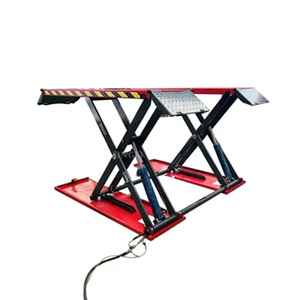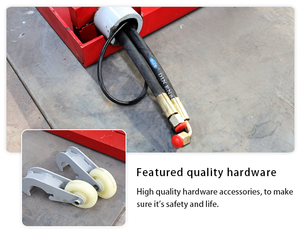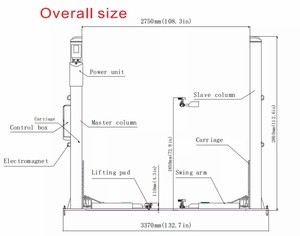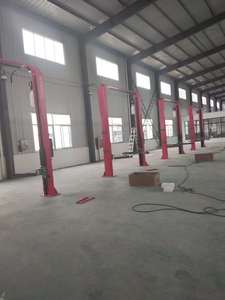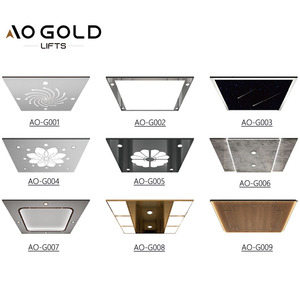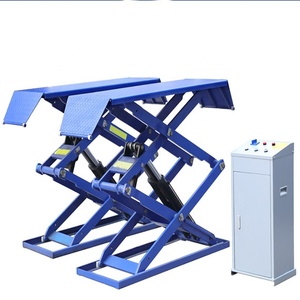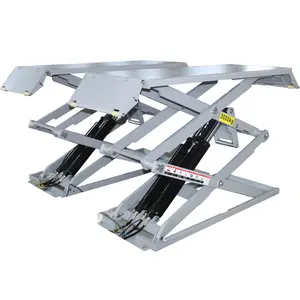Types of Low Rise Lift
Low-rise lifts are specialized equipment designed to lift vehicles with minimal ground clearance, such as sports cars, luxury vehicles, and supercars. These lifts are essential tools in auto repair shops, car detailing facilities, and for hobbyist mechanics working with low-profile vehicles. Let's explore the various types of low-rise lifts available in the market:
Portable Car Lift
Designed for mobility and convenience, portable car lifts are lightweight and compact for easy transport and storage. They typically feature:
- Hydraulic or electric motor power systems
- Telescoping arms for reaching under low-clearance vehicles
- Collapsible design for compact storage
Best for: Mobile mechanics, small workshops, and occasional use
Scissor Lifts
Featuring a distinctive X-shaped mechanism, low-rise scissor lifts provide vertical lifting without tilting. Key characteristics include:
- Crisscross pattern that folds in on itself
- Low maintenance requirements
- Stable lifting platform for various vehicle types
Best for: Service centers requiring precise vertical lifting with minimal footprint
Four Post Lifts
The most common low-rise lift type, four-post lifts offer exceptional stability and reliability with:
- Four vertical posts supporting the lift platform
- High weight capacity for heavier vehicles
- Available in both fixed and portable configurations
Best for: Professional garages and workshops servicing various vehicle types
In-ground Lifts
Installed in a specially prepared pit, in-ground lifts offer a clean workshop appearance with:
- Two-post or four-post configurations
- Space-efficient design when not in use
- Ergonomic working height for mechanics
Best for: Professional shops with space constraints and aesthetic requirements
Low-rise Parking Lift
Designed specifically for maximizing parking space, these lifts feature:
- Vertical lifting up to 7 feet high
- Compact design for low-ceiling environments
- Dual functionality for parking and maintenance
Best for: Residential garages, car collectors, and commercial parking facilities
Expert Tip: When selecting a low-rise lift type, consider not only your immediate needs but also future requirements. Factors such as vehicle types serviced, available space, mobility needs, and budget all play crucial roles in determining the most suitable lift for your specific situation.
| Lift Type | Mobility | Space Required | Weight Capacity | Best Application |
|---|---|---|---|---|
| Portable Car Lift | High | Minimal | 2,000-6,000 lbs | Mobile mechanics, home garages |
| Scissor Lift | Medium | Small-Medium | 3,000-10,000 lbs | Professional shops, tight spaces |
| Four Post Lift | Low-Medium | Large | 8,000-15,000 lbs | Full-service garages, heavy vehicles |
| In-ground Lift | None | Medium (visible) | 7,000-15,000 lbs | Dealerships, premium service centers |
| Low-rise Parking Lift | Low | Medium | 6,000-10,000 lbs | Residential/commercial parking solutions |
Specifications and Maintenance of Low-Rise Lifts
Understanding the technical specifications and implementing proper maintenance procedures are crucial for maximizing the performance, safety, and longevity of low-rise lifts. Here's what you need to know:
Key Technical Specifications
Weight Capacity
Most low-rise lifts are designed for light-duty vehicles with typical capacities ranging from 3,000 to 4,000 lbs. Always verify that your lift's capacity exceeds your heaviest vehicle's weight by at least 10% for safety margin.
Maximum Lift Height
Low-rise lifts typically elevate vehicles between 30 and 48 inches from the ground. This height range is specifically designed for undercarriage access while maintaining a low profile in space-constrained environments.
Lift Time
The time required to reach maximum elevation ranges from 30 seconds to 1 minute for most low-rise lifts. Faster lift times increase productivity but may require more powerful hydraulic systems.
Power Requirements
Hydraulic systems typically operate on standard 110V power, though some heavy-duty models may require 220V. Verify your facility's electrical capacity before purchasing to ensure compatibility.
Low-Rise Lift Specifications Comparison
Essential Maintenance Procedures
Proper maintenance ensures optimal performance, extends equipment lifespan, and maintains safety standards. Implement these maintenance practices:
| Maintenance Task | Frequency | Description | Importance |
|---|---|---|---|
| Clean Surfaces | Daily/Weekly | Remove dirt, dust, and debris using damp cloth or mild soap | High |
| Inspection | Monthly | Check cables, safety locks, hydraulic fluid, and wear points | Critical |
| Lubrication | Per schedule | Lubricate moving parts (wheel bearings every 6 months) | High |
| Hydraulic System Check | Quarterly | Inspect for leaks, check fluid levels, test pressure | Critical |
| Safety Certification | Annually | Professional inspection to maintain CE/ANSI compliance | Mandatory |
Safety Warning: Only trained and qualified personnel should operate low-rise lifts. Comprehensive training should cover proper use procedures, weight capacity limitations, safety protocols, and emergency procedures. Documenting all training sessions is recommended for liability protection.
How to Choose Low Rise Lifts
Selecting the right low-rise lift requires careful consideration of multiple factors to ensure the equipment meets your specific needs, provides safe operation, and delivers long-term value. Here's a comprehensive guide to making an informed choice:
Lifting Capacity Assessment
The most critical selection factor is ensuring adequate capacity for your heaviest vehicles:
- Calculate the average weight of vehicles you'll service
- Add extra weight for fuel, fluids, and equipment
- Choose a lift with at least 10-20% higher capacity than needed
- Consider future needs and potential heavier vehicles
Remember: Inadequate capacity compromises safety and can damage both lift and vehicle
Maximum Lift Height Requirements
The lift height determines accessibility and workspace under the vehicle:
- Assess typical maintenance tasks you'll perform
- Consider technician height and working comfort
- Ensure ceiling height accommodates fully raised vehicles
- Balance between sufficient access and space constraints
Optimal range: 30-48 inches for most undercarriage work
Space Considerations
Evaluate your available workspace carefully:
- Measure total footprint needed including safety margins
- Account for vehicle approach and exit paths
- Consider technician working space around the lift
- Verify floor strength and levelness requirements
Pro tip: Create a floor plan layout before purchasing
Safety Features Evaluation
Never compromise on safety features:
- Multiple locking positions at different heights
- Emergency stop mechanisms and lowering systems
- Automatic safety locks that engage during lifting
- Certifications (CE, ANSI/ALI, etc.)
Critical: Verify third-party safety certifications
Ease of Operation
Look for intuitive controls, simple setup procedures, and ergonomic design. User-friendly lifts increase efficiency and reduce training time. Test operation if possible before purchasing.
Portability Needs
If mobility is important, prioritize lifts with wheels, lightweight construction, and folding capabilities. Portable models sacrifice some stability and capacity for convenience.
Construction Quality
Examine materials, welding quality, and overall build. Higher-grade steel, precision manufacturing, and quality hydraulics significantly impact durability and safety.
Adjustability Features
Seek adaptable arms, multiple pad configurations, and height adjustment options to accommodate various vehicle types, from sports cars to SUVs.
Expert Advice: While budget constraints are real, investing in a higher-quality low-rise lift typically results in better safety features, longer lifespan, and lower maintenance costs over time. Calculate total cost of ownership rather than focusing solely on purchase price.
How to DIY and Replace Low Rise Lift
While professional installation is recommended for complex lift systems, many low-rise lifts can be safely installed or replaced with proper planning and adherence to manufacturer guidelines. Follow these steps for a successful DIY installation:
Safety Notice: Always consult the manufacturer's specific installation manual. These general guidelines complement but do not replace detailed manufacturer instructions. Improper installation may void warranty and create safety hazards.
-
Select a Suitable Location
Choose a solid, level concrete surface with adequate thickness (typically 4-6 inches minimum). Ensure sufficient space around the lift for operation, vehicle approach/exit, and technician movement. Verify ceiling clearance exceeds maximum lift height plus vehicle height.
-
Prepare the Installation Area
Thoroughly clean the installation surface, removing all oil, grease, and debris. Check floor levelness with a straight edge and level - variations should not exceed ⅛ inch across the installation area. Mark mounting points precisely according to manufacturer specifications.
-
Assemble the Lift Components
Unpack all components and verify against the parts list. Assemble major components according to the manual sequence. Use proper torque specifications for all fasteners and bolts. Keep hydraulic fittings clean during assembly to prevent system contamination.
-
Secure the Lift to the Floor
For permanent installations, use the recommended anchoring system (typically concrete wedge anchors or epoxy anchors). Drill holes to exact depth and diameter specifications. Remove concrete dust from holes before setting anchors. Tighten anchor bolts to manufacturer's torque specifications.
-
Connect Hydraulic System
Install hydraulic lines with proper routing to avoid pinching or excessive bending. Fill reservoir with recommended hydraulic fluid. Bleed air from the system according to manufacturer instructions. Check for leaks at all connection points.
-
Electrical Connections
Connect power supply according to local electrical codes. Verify voltage requirements match your facility's power. Install disconnect switch within sight of the lift for emergency situations. Test controls for proper operation.
-
Test and Calibrate
Perform multiple no-load cycles to verify smooth operation. Check synchronization for dual-cylinder systems. Test all safety locks and emergency features. Make any necessary adjustments to level and alignment.
-
Load Testing
Gradually test with increasing weight, starting with 25% of rated capacity. Observe operation carefully at each stage. Verify all safety mechanisms engage properly under load. Check for hydraulic leaks or unusual noises.
Installation Pro Tip: Take photos throughout the installation process, especially of anchor placements, hydraulic connections, and electrical wiring. This documentation will prove invaluable for future maintenance or troubleshooting requirements.
Frequently Asked Questions
No, standard low-rise lifts are generally not suitable for heavy-duty trucks. These lifts are specifically designed for lighter vehicles like cars, sports cars, and lightweight SUVs, with typical weight capacities between 3,000-4,000 pounds. Heavy-duty trucks often exceed these weight limits by a significant margin.
Using a low-rise lift for a vehicle that exceeds its rated capacity is extremely dangerous and can result in catastrophic failure, potentially causing serious injury and damage to both the lift and vehicle. For heavy-duty trucks, specialized commercial-grade lifts with appropriate weight ratings (10,000+ pounds) are required.
Yes, low-rise lifts can be used for servicing electric vehicles. From a lifting perspective, EVs don't have special requirements compared to traditional vehicles. However, there are important considerations when working with electric vehicles:
- Verify the lift's weight capacity is sufficient for the EV (electric vehicles often weigh more than their ICE counterparts due to battery packs)
- Ensure the lift contact points avoid the battery compartment and follow manufacturer recommendations for safe lifting points
- Be aware of specific safety protocols for working with high-voltage systems
- Train technicians on EV-specific service procedures
Always refer to the EV manufacturer's service manual for proper lifting procedures and safety protocols.
While sometimes confused, low-rise lifts and scissor lifts serve different primary purposes:
| Feature | Low-Rise Lift | Scissor Lift |
|---|---|---|
| Primary Purpose | Vehicle maintenance and repair | Construction/industrial personnel elevation |
| Maximum Height | 30-48 inches typically | Up to 50+ feet for industrial models |
| Platform Design | Vehicle-specific contact points | Large platform for people and materials |
| Lifting Mechanism | Varies (hydraulic, pneumatic) | X-pattern folding supports |
| Mobility | Generally stationary during use | Often mobile with wheels/castors |
Some automotive scissor lifts do exist that combine elements of both designs, but they typically have different operational characteristics than construction-oriented scissor lifts.
Portability varies significantly among low-rise lift models:
- Portable Models: Many low-rise lifts are specifically designed for portability, featuring wheels, lightweight construction, and collapsible designs. These typically weigh between 200-500 pounds and can be moved around a workshop relatively easily.
- Semi-Portable Models: Some models can be relocated with assistance but aren't designed for frequent movement. They might have removable wheels or require partial disassembly.
- Fixed Models: Larger capacity low-rise lifts are often permanent installations anchored to the floor for maximum stability and safety.
When portability is a priority, look for models specifically marketed as mobile or portable, but be aware that increased portability often comes with trade-offs in stability and maximum weight capacity.













